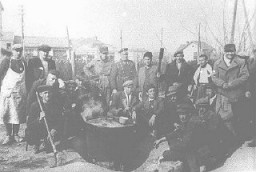You searched for: 奢侈品商城项目搭建【TG���������@EK7676】平台包网搭建奢侈品商城项目搭建【TG���������@EK7676】平台包网搭建29WSEOg1bc
<< Previous | Displaying results 81-90 of 183 for "奢侈品商城项目搭建【TG���������@EK7676】平台包网搭建奢侈品商城项目搭建【TG���������@EK7676】平台包网搭建29WSEOg1bc" | Next >>
-
The 45th Infantry Division during World War II
ArticleThe 45th Infantry Division participated in major WWII campaigns and is recognized for liberating the Dachau concentration camp in 1945.
-
Page 5 of passport issued to Setty Sondheimer
DocumentPage 5 of a passport issued to Setty Sondheimer by the German Consulate in Kovno on January 29, 1938. This page contains three visas: (1) visa for Kovno valid from August 27, 1940, until December 31, 1940 (2) a second visa for Kovno valid until June 30, 1941, and (3) first visa for Yokohama, Japan, valid from June 7, 1941, until June 30, 1942. Unable to emigrate from Japan, Setty remained there until she was able to emigrate to the United States in 1947. [From the USHMM special exhibition Flight and…
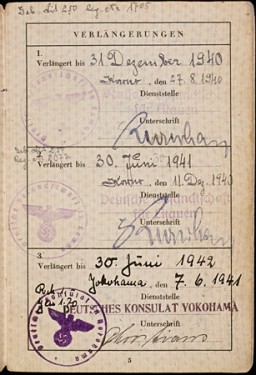
-
Screening of concentration camp film footage
FilmUS prosecutor Thomas Dodd introduces the film compilation "Nazi Concentration Camps." At the end of the courtroom scene shown here, the lights are dimmed for the screening. The footage, filmed as Allied troops liberated the concentration camps, was presented in the courtroom on November 29, 1945, and entered as evidence in the trial.
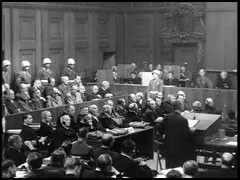
-
Dachau after liberation
FilmThe Dachau concentration camp, northwest of Munich, Germany, was the first regular concentration camp the Nazis established in 1933. About twelve years later, on April 29, 1945, US armed forces liberated the camp. There were about 30,000 starving prisoners in the camp at that time. The film seen here was edited from original footage shot by Allied cameramen as liberating troops entered Dachau. It was discovered in the archives of the Imperial War Museum in 1984 and was never completed.
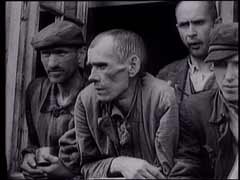
-
Jews from Macedonia before deportation
PhotoJews from Bulgarian-occupied Macedonia who were rounded up and assembled at the Tobacco Monopoly transit camp in Skopje before deportation to the Treblinka killing center. Skopje, Yugoslavia, March 1943. The Jews of Bulgarian-occupied Thrace and Macedonia were deported in March 1943. On March 11, 1943, over 7,000 Macedonian Jews from Skopje, Bitola, and Stip were rounded up and assembled at the Tobacco Monopoly in Skopje, whose several buildings had been hastily converted into a transit camp. The…
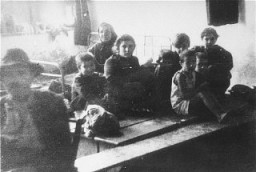
-
Macedonian Jews leave the Tobacco Monopoly transit camp in Skopje for the deportation trains
PhotoMacedonian Jews leave the Tobacco Monopoly transit camp in Skopje for the deportation trains. Skopje, Yugoslavia, March 1943. The Jews of Bulgarian-occupied Thrace and Macedonia were deported in March 1943. On March 11, 1943, over 7,000 Macedonian Jews from Skopje, Bitola, and Stip were rounded up and assembled at the Tobacco Monopoly in Skopje, whose several buildings had been hastily converted into a transit camp. The Macedonian Jews were kept there between eleven and eighteen days, before being…
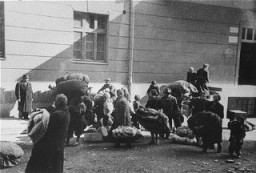
-
Warsaw ghetto uprising, 1943
MapThe city of Warsaw is the capital of Poland. Before World War II, Warsaw was the center of Jewish life and culture in Poland. Warsaw's prewar Jewish population of more than 350,000 constituted about 30 percent of the city's total population. The Warsaw Jewish community was the largest in both Poland and Europe, and was the second largest in the world, behind that of New York City. The Germans occupied Warsaw on September 29, 1939. In October 1940, the Germans ordered the establishment of a ghetto in…

-
Jews from Macedonia before deportation to the Treblinka killing center
PhotoJews from Macedonia who were rounded up and assembled in the Tobacco Monopoly transit camp before deportation to the Treblinka killing center. Skopje, Yugoslavia, March 1943. The Jews of Bulgarian-occupied Thrace and Macedonia were deported in March 1943. On March 11, 1943, over 7,000 Macedonian Jews from Skopje, Bitola, and Stip were rounded up and assembled at the Tobacco Monopoly in Skopje, whose several buildings had been hastily converted into a transit camp. The Macedonian Jews were kept there…

-
Jews outside the Monopol tobacco factory transit camp
PhotoJews outside the Monopol tobacco factory, used as a transit camp by Bulgarian authorities during deportations from Macedonia to the Treblinka killing center in German-occupied Poland. Skopje, Yugoslavia, March 1943. The Jews of Bulgarian-occupied Thrace and Macedonia were deported in March 1943. On March 11, 1943, over 7,000 Macedonian Jews from Skopje, Bitola, and Stip were rounded up and assembled at the Tobacco Monopoly in Skopje, whose several buildings had been hastily converted into a transit camp.…

-
Jews prepare soup outside the Monopol tobacco factory transit camp
PhotoJews prepare soup outside the Monopol tobacco factory, used as a transit camp by Bulgarian authorities during deportations of Jews from Macedonia. Skopje, Yugoslavia, March 1943. The Jews of Bulgarian-occupied Thrace and Macedonia were deported in March 1943. On March 11, 1943, over 7,000 Macedonian Jews from Skopje, Bitola, and Stip were rounded up and assembled at the Tobacco Monopoly in Skopje, whose several buildings had been hastily converted into a transit camp. The Macedonian Jews were kept there…
